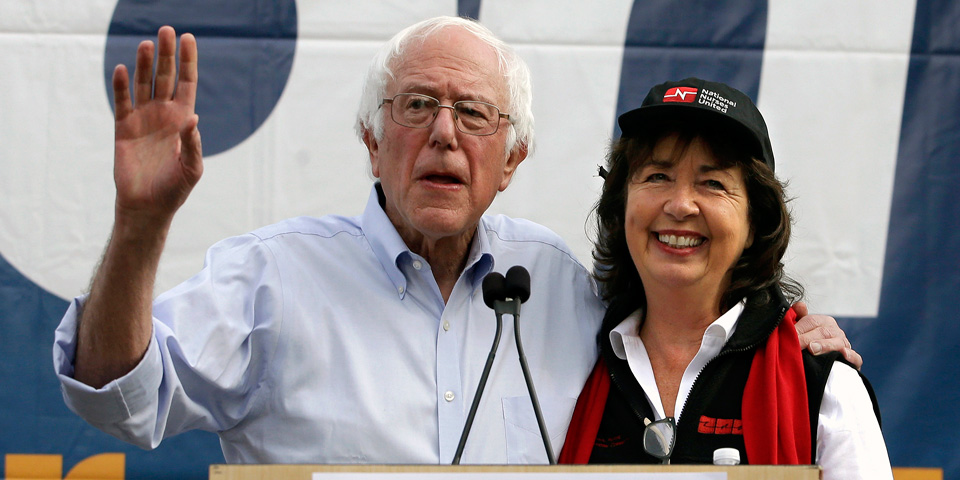
SAN ANTONIO, Texas — Four months after their defeat in the 2016 election, leaders of the nation’s unions are still struggling to figure out why – and what to do next.
Interviews with union presidents at the AFL-CIO Executive Council meeting in San Antonio, March 13-14, revealed a variety of opinions as to the reasons for the result.
Despite labor’s commitments of people and dollars to pro-worker candidates nationwide – an investment so large that other labor projects were often put on the back burner – the polls show that union households defected in droves last November to vote for Republican presidential nominee Donald Trump.
With a virtual 50-50 split between Trump, the Electoral College vote winner, and Democratic nominee Hillary Rodham Clinton, whom most union leaders backed, Clinton lost.
Further, an expected takeover of the GOP-led U.S. Senate failed, U.S. House gains by Democrats were minimal, several Democratic-held governorships – notably in Missouri – were lost to anti-worker Republicans pushing right to work laws, and the GOP won total control in even more states than before.
House Minority Leader Nancy Pelosi, D-Calif., speaking behind closed doors to the council on March 13, was optimistic, citing Trump’s troubles and record unpopularity as reasons for optimism for the election that will take place 18 months from now. But Rose Ann DeMoro, executive director of National Nurses United, and Cecil Roberts, the Mine Workers president, were dubious.
“The mood for change was a common denominator” of the campaigns of both Trump and Sen. Bernie Sanders (Ind-Vt.), who strongly challenged Clinton in the Democratic primaries, she said in an interview with Press Associates Union News Service.
Sanders was authentic, he excited people and he challenged the establishment that they didn’t trust, DeMoro explained. “Not supporting him was a fatal error and you can quote me on that,” she declared. Her union was the first of the few who backed the Vermonter.
NNU, like other Sanders backers, “wanted a more just society.” And while Republican candidates – and specifically Trump – “knew their base” and “fed red meat to it,” the Democrats did neither. “Instead, they abandoned ideology.”
Trump, meanwhile, ran against everybody, and that had strong appeal to disaffected voters nationwide. He’s “a candidate with a cult of personality, not a political party,” DeMoro explains. His supporters “didn’t necessarily identify him as a Republican, but as someone who’s outside both parties.”
So Clinton got the Democratic base vote, but it wasn’t enough.
But that still doesn’t account for the other losses up and down the ticket. Roberts, who personally campaigned for Clinton though his union stayed neutral in the presidential contest, said the damage started long before the 2016 vote.
He drew on his home state of West Virginia, once a Democratic and UMWA bastion, but which hasn’t gone for a Democratic presidential nominee since the 1996 election. Incumbent Democratic President Barack Obama lost every county in the Mountaineer State in 2012, the state legislature is now GOP-controlled and the state’s five-person congressional delegation has one Democrat, Sen. Joe Manchin, a moderate-conservative.
And his West Virginia is like the rest of Appalachia – plus areas of Ohio, Pennsylvania, Michigan and Wisconsin – that provided Trump with the popular votes he needed to win those states and the White House, Roberts said.
“We’ve been losing ground in these areas for 17 years,” Roberts said of both the Democrats and labor. Roberts himself saw the political deluge coming, warning Obama and his staff in the run-up to the 2008 election that “if you don’t make a concerted effort in these areas, you’ll lose them.” His warning was unheeded, he said in an interview with two reporters.
Obama lost West Virginia. Clinton lost West Virginia and the rest. Roberts cited economic woes as the main reason.
“People are concerned about the jobs they lost, about the jobs they might lose, and the Democrats weren’t thinking about that,” he says. Though Roberts did not say so, Trump and the Republicans were. Trump visited coal country at least three times during the campaign and the GOP hung what it called Obama’s “war on coal” – a bogus term used to denigrate any type of regulation or restriction on the coal industry — around Clinton’s neck.
So what do the Democrats, and union leaders and activists, do about it? Again, there’s a split.
Roberts says the solution is to talk about real issues in the places where people are affected. He cited the jammed town hall meetings hosted by lawmakers of both parties so far this year, where Congressmembers have been inundated by people scared they’re going to lose their health care under Republican plans.
“People are looking at things that affect their lives. People who voted for Trump are not worried about the Russians” and their government’s possible interference in the 2016 campaign, on Trump’s side. That topic currently consumes much of Washington’s political conversation and the so-called mainstream media.
“But if they can’t take their child to the doctor because of the GOP health care plans, they get upset.”
“We organize from the grass-roots up,” declared AFSCME President Lee Saunders, whose union is the AFL-CIO’s largest and who chairs the federation’s political committee.
“We lost 1,000 state legislators in the last ten years,” Saunders said, referring to Democratic allies of unionists. In a brief interview on his way to catch a plane, Saunders said labor must emphasize gubernatorial and state legislative races in its organizing for next year’s off-year elections.
Trump’s mistakes and GOP issue stands will help, Saunders said. With headlines saying 26 million people could lose their health insurance from the plan the Republicans are pushing through Congress, “people understand the importance of it now. This is a wake-up call and people are stepping up to the plate” against the GOP.
DeMoro says that’s not good enough.
Her solution is to build a mass movement, notably including progressive unions and the Sanders backers, to draft a progressive agenda that people can understand, and recruit and evaluate 2018 candidates who will support it. There has “to be a new paradigm” of a program that can appeal to people, especially millennials and younger voters, she adds.
Otherwise, DeMoro warns, for unionists, workers and the Democratic Party, “2018 will be 2016 all over again.”

MOST POPULAR TODAY

‘Warning! This product supports genocide’: Michigan group aims to educate consumers

Ohio: Franklin County treasurer attends Netanyahu meeting, steps up Israel Bond purchases

After months of denial, U.S. admits to running Ukraine biolabs

“Trail of Tears Walk” commemorates Native Americans’ forced removal

Hold the communism, please: SFMOMA’s Diego Rivera exhibit downplays artist’s radical politics






Comments